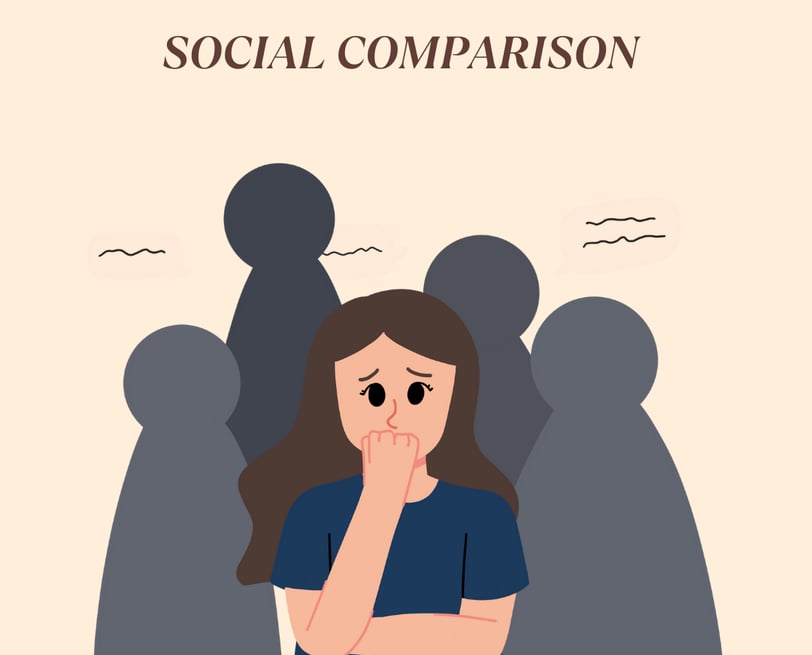Social Comparison
Social comparison is a behavior in which individuals evaluate certain aspects of themselves by comparing them with others.........
SOCIAL PSYCHOLOGY
1/29/20253 min read


Social comparison is a behavior in which individuals evaluate certain aspects of themselves by comparing them with others. This process helps in gaining a better self-assessment and understanding of one’s social world. The way individuals use others as a reference point is a central human concern, essential for adaptation and survival (Suls & Wheeler, 2000).
Why Do People Engage in Social Comparison?
Accurate self-evaluation requires answering three broad questions:
Why do people compare themselves with others?
To whom do they compare themselves?
How do they compare?
From an evolutionary perspective, individuals compare themselves under standard conditions to ensure accurate self-assessment and survival.
Identity and Social Comparison
Identity refers to people’s perceptions of their characteristics and abilities, which are largely influenced by social comparisons. Two types of comparisons explain self-evaluation:
Social Comparison: Using others as a standard for external validation and understanding oneself. People have a fundamental need to maintain a stable and positive self-view (Marsh, 1986).
Temporal Comparison: Using prior self-related information for self-evaluation.
Eccles (2009) stated that individuals assess their skills by comparing their performances with others and with their past performances.
Comparison Standards
Individuals compare themselves using different standards, including:
Peers
Celebrities
Past selves
Motivation for Comparison
People engage in social comparison for various reasons:
Accuracy: To understand where they stand.
Improvement: To set goals for growth.
Self-enhancement: To boost self-image.
Social Comparison Theory
Leon Festinger (1954) introduced Social Comparison Theory, which states that individuals evaluate their opinions, abilities, and emotions by comparing themselves to others. Festinger suggested that humans have an innate drive for self-evaluation, and comparisons serve as a protective mechanism for self-preservation.
Key Assumptions:
Comparisons are most effective when the comparison standard shares relevant attributes.
Individuals tend to prefer slightly superior comparison standards to evaluate abilities.
Downward comparison (comparing to someone worse off) often leads to a positive self-evaluation (Wheeler & Suls, 2005).
Upward comparison (comparing to someone better off) may result in motivation or feelings of inadequacy (Wheeler & Miyake, 1992).
In academic settings, students tend to compare themselves with slightly better-performing peers to gain insights and improve their own performance. This aligns with the “unidirectional drive upward” hypothesis (Wheeler & Miyake, 1992).
Types of Social Comparison
Upward Comparison
Comparing oneself to someone better off.
Can be inspiring or lead to inferiority.
Often motivated by self-improvement (Marsh et al., 2010).
Downward Comparison
Comparing oneself to someone worse off.
Can enhance self-esteem or lead to complacency.
Driven by self-enhancement and self-protection motives (Wills, 1981).
Personality and Social Comparison
Diener and Fujita (1997) suggested that social comparison varies based on personality traits:
High Social Comparison Orientation (SCO): Strong activation of self-awareness, sensitivity to others' feelings, and concern about public image.
Negative Affectivity & Uncertainty: High levels of neuroticism and self-doubt are associated with frequent social comparisons.
High SCO in Teamwork: Beneficial in collaborative environments where comparison helps in skill improvement.
Temporal Comparison Theory (TCT)
Albert (1977) introduced Temporal Comparison Theory, which states that individuals evaluate themselves by comparing their current performance with past performance. Unlike Social Comparison Theory, TCT emphasizes maintaining a coherent self-identity over time.
Assumptions:
People prefer comparisons with their recent past rather than distant past.
Downward temporal comparisons (comparing to past lower abilities) boost self-confidence, whereas upward temporal comparisons (comparing to past higher abilities) may lower self-esteem.
Dimensional Comparison Theory (DCT)
Möller and Marsh (2013) proposed Dimensional Comparison Theory, which focuses on internal frames of reference. It explains how individuals compare abilities across different domains (e.g., math vs. art) instead of comparing with others.
Key Principles:
Intra-individual Comparison: Comparing one's skills across different domains (e.g., "I am better at math than art").
Contrast Effects: Excelling in one domain may lower self-concept in another.
Assimilation Effects: Success in one domain may enhance confidence in a related domain.
Mechanisms of Dimensional Comparison:
Cognitive: Evaluating specific abilities.
Affective: Emotional response to comparisons.
Examples:
A student excelling in math but struggling in art might:
Contrast Effect: Think they are “bad at art” due to their math skills.
Assimilation Effect: Believe they are “good at problem-solving” due to overlapping cognitive abilities.
Influences on Dimensional Comparison:
Cultural Values: Societal emphasis on specific skills.
Personal Interests: Individual preferences shape comparisons.
Social Environment: Feedback from peers and mentors.
Consequences of Social Comparison
Positive Outcomes:
Better self-awareness and understanding of strengths.
Improved focus on self-development.
Motivation for growth.
Negative Outcomes:
Decreased self-esteem in less favored domains.
Over-specialization in one area.
Behavioral Consequences of Comparison
When individuals notice discrepancies between their abilities and others’, they may develop competitive behaviors. If no opportunity for self-repair exists, negative emotions may arise. However, when self-improvement is possible, competition can drive motivation and growth.
References
Albert, S. (1977). Temporal comparison theory. Psychological Review, 84(6), 485-503.
Diener, E., & Fujita, F. (1997). Social comparison and subjective well-being. Journal of Personality and Social Psychology, 73(1), 49-64.
Eccles, J. S. (2009). Who am I and what am I going to do with my life? Journal of Research on Adolescence, 19(1), 1-12.
Festinger, L. (1954). A theory of social comparison processes. Human Relations, 7(2), 117-140.
Möller, J., & Marsh, H. W. (2013). Dimensional comparison theory. Psychological Review, 120(3), 544-560.
Suls, J., & Wheeler, L. (2000). A selective history of classic and neo-social comparison theories. Handbook of Social Comparison, 3-19.
Wheeler, L., & Miyake, K. (1992). Social comparison in everyday life. Journal of Personality and Social Psychology, 62(5), 760-773.
